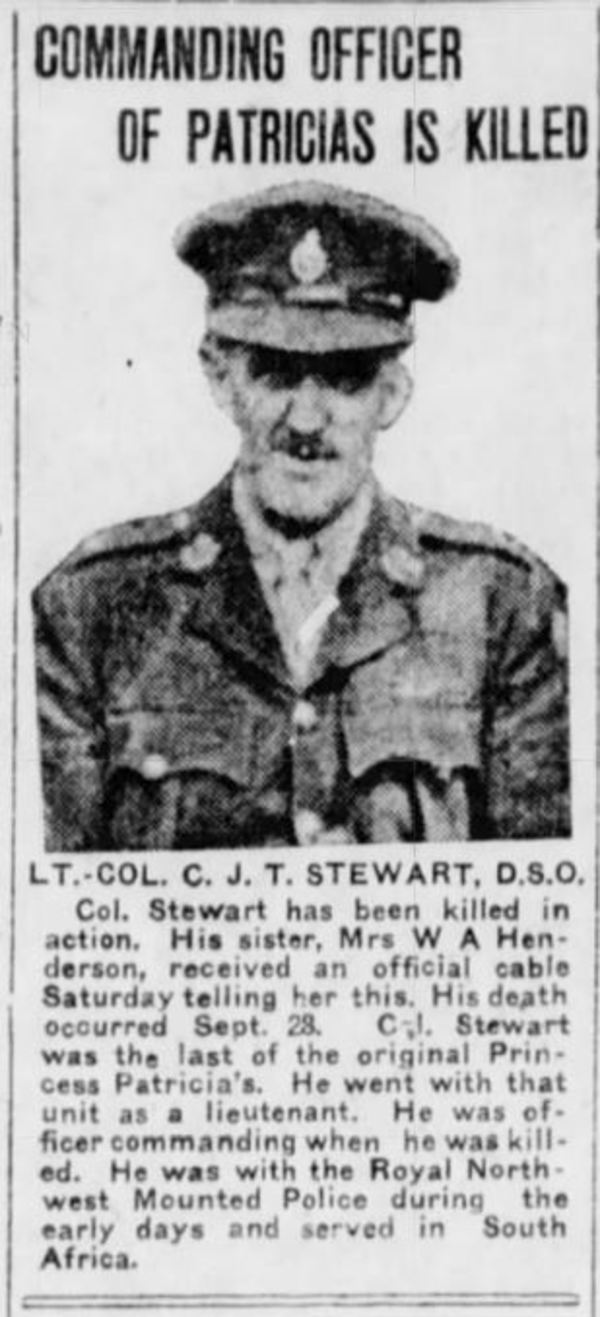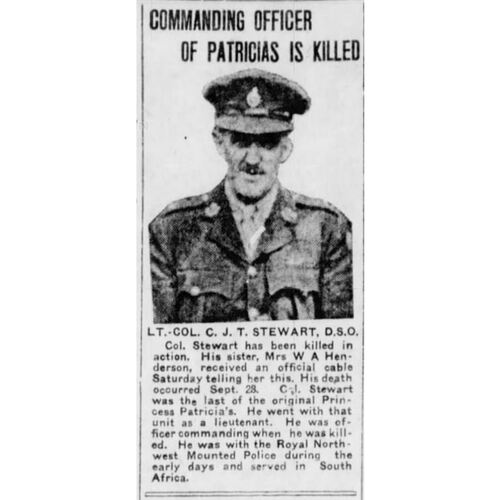
Source: Link
STEWART, CHARLES JAMES TOWNSHEND, NWMP officer and army officer; baptized 25 Dec. 1874 in Amherst, N.S., one of the twelve children of Charles James Stewart and Amelia Isabella McKay King; grandson of Alexander Stewart*; d. unmarried 28 Sept. 1918 near Raillencourt, France.
Charlie Stewart, as he was called, belonged to a prominent and wealthy Nova Scotia family. After attending the Royal Military College of Canada in Kingston, Ont., from 1892 to 1894, he was discharged at his “own and parent’s request,” it was later recorded, but in fact he was expelled for gambling. He subsequently worked as an insurance clerk in Halifax while serving as a lieutenant in the 66th Battalion of Infantry (Princess Louise Fusiliers). A superb athlete, he was equally proficient in cricket, hockey, football, tennis, and golf. At some time he became friendly with businessman William Maxwell Aitken*.
Stewart joined the North-West Mounted Police on 3 April 1896 and was engaged as a constable for a five-year term. During the Klondike gold-rush in the Yukon he served from mid 1898 with the Lower Laberge and Tagish detachments. Ever watchful over his son’s career, Stewart’s father asked that he be promoted, and then that he be permitted to join the contingent being formed in Canada for the South African War, but both requests were turned down. Stewart was promoted corporal on 1 June 1900 and re-engaged for three years on 3 June 1901. Shortly afterwards he reverted to constable for having struck a bullying corporal.
In December 1901 Stewart’s father again attempted to get his son sent to Africa, this time with the Canadian Mounted Rifles, through the influence of federal cabinet ministers William Stevens Fielding* and Clifford Sifton*. As a result of a flurry of telegrams Stewart was granted one year’s leave. But instead of joining the CMR he sailed to Britain, where he was commissioned in the Imperial Yeomanry for service in southern Africa as a transport officer. On learning this news, the NWMP granted him a free discharge, dated 23 April 1902. Stewart returned to Halifax in November 1904, unsuccessfully applied for a commission in the NWMP, and shortly disappeared into the Yukon. He subsequently drifted, according to his nephew the future ambassador Charles Stewart Almon Ritchie, “into jobs and bars in Calgary or Edmonton”; “eking out his earnings by his gains at poker, he left a trail of legends and stories.” He also worked on the railways and narrowly escaped death from starvation and cold while on a trapping expedition to Hudson Bay. He arrived in Winnipeg just before World War I broke out.
Appointed lieutenant in Princess Patricia’s Canadian Light Infantry on 12 Aug. 1914 while passing through Ottawa, doubtless because of his family connections, he sailed with the regiment to England, arriving on 14 October. One night he accidentally set fire to his and Talbot Mercer Papineau’s tent; both were seriously burned and were unable to accompany the unit, part of the 27th British Division, to France on 20 December. They recovered quickly in the care of the dowager Countess of Donoughmore, mother-in-law of the PPCLI’s first commanding officer, who befriended them. Papineau considered Stewart “the most pronounced character I have ever met . . . He has the vitality and appearance of Hercules but remains normal by constant undermining operations – such as fifty cigarettes a day and the output of a whiskey factory. He plays a perfect game of bridge, and recently took £90 from Bonar Law and Sir Edward Grey.”
By the time Stewart rejoined the regiment on 21 Jan. 1915 it was on the Saint-Eloi (Sint-Elooi) front, south of Ypres (Ieper), Belgium. On 15 March, while commanding a platoon, he received a gunshot wound in the chest. A chaplain asked him if he wished him to pray. “Yes, pray like hell” was his response. Invalided to England, after recovery he rejoined the regiment near Armentières, France, on 17 July 1915 and was promoted captain ten days later. The PPCLI returned to the Ypres salient in January 1916, after having been incorporated in the 3rd Division of the Canadian Corps [see Malcolm Smith Mercer]. Granted leave on 17 May, Stewart missed the battle of Mount Sorrel, in which the unit suffered 400 casualties, including 19 of 23 officers. When Stewart returned on 5 June the PPCLI was nursing its wounds and training reinforcements in the rear. He had been promoted major two days earlier, and he was much involved in the reorganization that followed.
As ever, he was ebullient. “Whiskey has always been short, and Charlie had been depressed,” reported Papineau, but when he received a bottle he leaped and danced and “put it upon the mantelpiece and then bowed and salaams made.” At the battle of Flers-Courcelette, which began on 15 September, Stewart “led an attack which captured two enemy trenches, and showed great determination, both in the attack and in the consolidation of the position won.” For his conspicuous gallantry he was awarded the Distinguished Service Order, and he was later mentioned in dispatches.
On 17 December Stewart was granted leave to go to England, where a medical board declared him unfit to return to duty and recommended extended rest. He sailed to Halifax at his own expense and visited his sister Lilian Constance Harriette, wife of William Bruce Almon Ritchie. Charles Ritchie recalls that “he did not talk of martial exploits, he had no words of hatred for the Hun, and what he did say sounded a wrong note to our ears. His stories of muddle and confusion in the High Command, his contempt for the red-tabbed staff officers, were like tales told out of school.” The family was also shocked by his “desperate jokes of fighting men that sounded meaninglessly callous to us.” Stewart also revived an old romance with “Aunt Lucy,” no relation, which drew the comment, “She had never looked more lovely than in those few days when he was with us.” He had had many such involvements, “for he had the attraction of the undomesticated man, restless and susceptible.” Yet in a letter to his sister the day before he was killed he wrote, “You are the only one I have ever loved.”
By 4 May 1917 he was back with the regiment in the area around Lens, France, having missed the battle of Vimy Ridge. On 8 September he was invalided to England, and on his return to duty two months later he was appointed second in command, having missed a third important battle, Passchendaele. On 30 March 1918, following Agar Stewart Allan Masterton Adamson*’s resignation, Stewart was promoted lieutenant-colonel and appointed commanding officer. Most of the summer was spent refitting and training for the coming Allied counter-offensive.
Under Stewart’s leadership the PPCLI took part in August in the battles of Amiens and the Scarpe. In the latter battle it lost 60 per cent of its officers and 30 per cent of its men. On 27 September, tired and under strength, the PPCLI entered the battle of Cambrai. The following day, while advancing with his battalion across open ground near Raillencourt, west of Cambrai, Stewart was killed by a German shell. The citation for a bar to the DSO, awarded posthumously, praised “his extra-ordinary energy and resourcefulness, his sound tactical knowledge and ability,” and added that “his consistent cheerfulness, his complete disregard of danger and his personal example were undoubtedly instrumental in the success of his Battalion.” He was also awarded the French Croix de Guerre and received a second mention in dispatches. His body lies in the Ontario Cemetery, near Sains-lès-Marquion, west of Cambrai.
In Stewart’s obituary it was remarked that he had been “an extraordinary man, and beloved by all who understood and admired his true character.” “‘The men would follow him anywhere; he seemed to bear a charmed life,’” reported Charles Ritchie. “Yet what was his life until the War gave him his chance? A life of adventure wearing down into plain middle-aged failure.” Stewart’s propensity for drinking whisky, romancing, telling stories, and gambling was, to say the least, unprofessional, and it is difficult to countenance that it did not affect his relations with subalterns and men. His main claim to fame, in the end, seems to be that he was the last officer of the “Old Originals” to command the PPCLI during World War I.
NA, RG 18, 3406, file 3136; RG 150, Acc. 1992–93/166. PANS, MG 100, 234, no.22a. Private arch., J. J. B. Pariseau (Ottawa), Jean Pariseau, “The founder and the First World War” (lecture notes prepared in 1988 for the Princess Patricia’s Canadian Light Infantry and used annually for instructing new officers). Halifax Herald, 4 Oct. 1918. Canada in the Great World War; an authentic account of the military history of Canada from the earliest days to the close of the war of the nations (6v., Toronto, [1917–20]). Sandra Gwyn, Tapestry of war: a private view of Canadians in the Great War (Toronto, 1992) (includes photos of Stewart as a lieutenant, pp.88–89, and as a major, p.312). Ralph Hodder-Williams, Princess Patricia’s Canadian Light Infantry, 1914–1919 (2v., London, 1923). Nicholson, CEF. C. [S. A.] Ritchie, My grandfather’s house: scenes of childhood and youth (Toronto, 1987), 4–5, 29–31, 36–37, 44, 133–34. Jeffery Williams, Princess Patricia’s Canadian Light Infantry (rev. ed., London, 1985).
Cite This Article
Jean Pariseau, “STEWART, CHARLES JAMES TOWNSHEND,” in Dictionary of Canadian Biography, vol. 14, University of Toronto/Université Laval, 2003–, accessed December 29, 2025, https://www.biographi.ca/en/bio/stewart_charles_james_townshend_14E.html.
The citation above shows the format for footnotes and endnotes according to the Chicago manual of style (16th edition). Information to be used in other citation formats:
| Permalink: | https://www.biographi.ca/en/bio/stewart_charles_james_townshend_14E.html |
| Author of Article: | Jean Pariseau |
| Title of Article: | STEWART, CHARLES JAMES TOWNSHEND |
| Publication Name: | Dictionary of Canadian Biography, vol. 14 |
| Publisher: | University of Toronto/Université Laval |
| Year of publication: | 1998 |
| Year of revision: | 1998 |
| Access Date: | December 29, 2025 |



